The civil society mobilises for European symbols everywhere in Europe
The Young European Federalists (JEF) ahad decided to undertake an action everywhere in Europe to react to the fact that the symbols had been isolated from the “new” Lisbon Treaty in order to show that it did not have a constitutional character any longer… and especially to satisfy the most nationalist governments.
Admittedly the symbols of the Union do not disappear de facto, but it is precisely because European leaders failed to include them de jure that young citizens in more than fifty cities in Europe took part in this militant action. This action goes beyond the issue of whether the text is good or not. It expresses above all the need for Europeans of living together in a Union of 27, which needs new rules for better functioning.
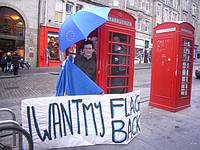
The rotating presidency of 6 months is certainly a thing of the past if the Lisbon Treaty enters into force with a President of the Council elected for a period of two and a half years; citizens would get the right to petition (1 million signatures needed), the Charter of Fundamental Rights would become binding (even if it is only in a protocol); the institutions would certainly function better than under the current Nice Treaty… But the important thing today is to show that we, especially the young generation, want to continue and deepen this tremendous adventure called the European integration.
European Parliament sensible to JEF’s appeal
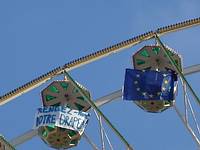
The Charter of Fundamental Rights of the European Union was proclaimed for the second time on Wednesday 12 December 2007, in Strasbourg, by the three institutions of the European Union: the Portuguese Prime Minister José Socrates (currently holding the EU Presidency) ) for the Council, the Commission president José Manuel Barroso and the President of the Parliament Hans-Gert Pöttering. But extreme left-wing and extreme right-wing MEPs chose to disrupt the official ceremony, under the pretext to ask for a referendum while they especially want to refuse any headway towards a political Europe.
The fact that they attack the Charter, which serves as a symbol of our will as Europeans to advance on common values, is not harmless. This choice shocked much of the EP’s hemicycle. The MEPs favourable to Community construction detected the attack made towards Europe there.
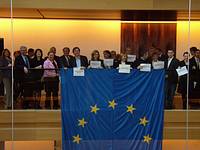
This is why more than twenty MEPs (among others Mr. Lipietz, Mr. Cavada, Mrs. Griesbeck, Mr. Leinen) took part in the action organized by JEF-Strasbourg inside the EP building! The spontaneity of the action prevented gathering more participants from the parliamentary rows, but they wanted to mark their attachment to the symbols that unite us as Europeans.
The citizen’s will to continue taking part in the European adventure
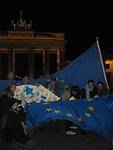
Fortunately, it is not only the civil society and the representatives of the European people that got mobilised. Sixteen member states adopted a declaration in which they affirm that these symbols will continue to illustrate for them “the common membership of the citizens to the European Union and their bond with the Union”; because it is on good terms with the citizens that the future of Europe must be decided.
The current tendency is to ask the question whether or not this Treaty should be ratified via referendum. In France we re-examine the cleavages between the yes and the no sides to redraw on this question:
• ex-defenders of the Yes do not want to remain in the framework of the Nice Treaty, even if this means having a treaty with reductions that enable it being ratified the parliamentary way. • ex-defenders of the No do not want a text being ratified far from the citizens whom they consider acquired by advance at their cause.
But what really happened? For two years, the no-side has not proposed anything and tore during the presidential campaign. Moreover, their call to the people hides above all their desire to make Europe fail. One especially sees it in the fact that no leader of the political extremes (neither left nor right) asks for a referendum in a pan-European dimension. They remain within a national framework and do not want the European people to decide. One sees well there their lack of interest for Europe.
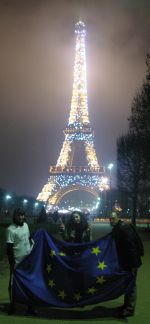
The Lisbon Treaty represents for European diplomats the occasion to close the institutional subject for a while. They are wrong. But it is from now up to the European citizens and their representatives (such as MEPs) to show their desire for Europe. The European parliamentary elections in 2009 seem henceforth their true objective.


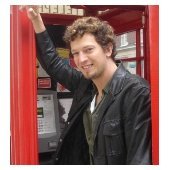
Follow the comments: |
|
